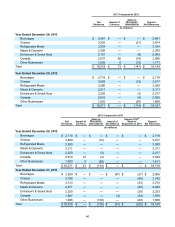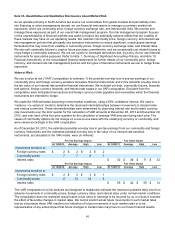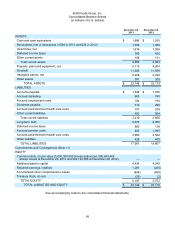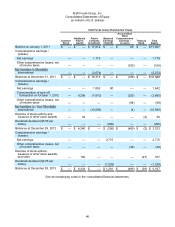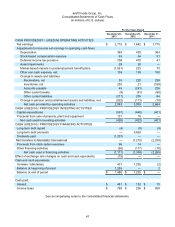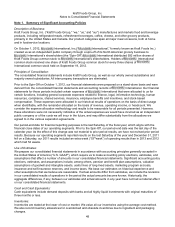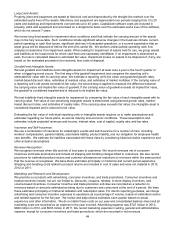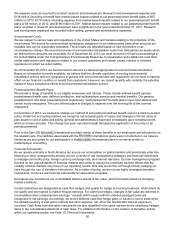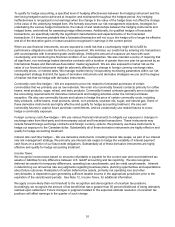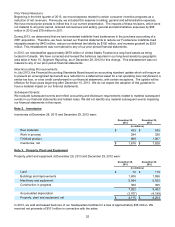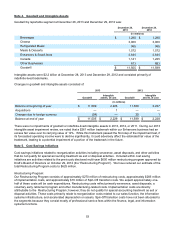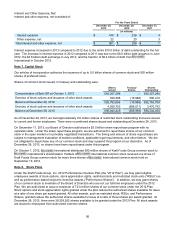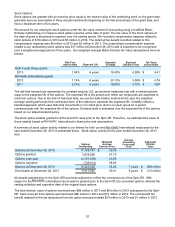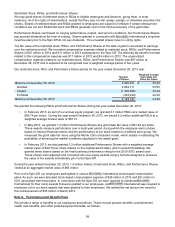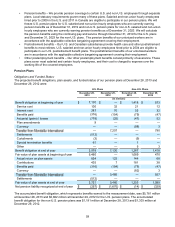Kraft 2013 Annual Report Download - page 52
Download and view the complete annual report
Please find page 52 of the 2013 Kraft annual report below. You can navigate through the pages in the report by either clicking on the pages listed below, or by using the keyword search tool below to find specific information within the annual report.
50
We expense costs as incurred for product research and development. Research and development expense was
$118 million (including a benefit from market-based impacts related to our postemployment benefit plans of $55
million) in 2013, $178 million (including expense from market-based impacts related to our postemployment benefit
plans of $6 million) in 2012, and $198 million in 2011. Market-based impacts related to our postemployment benefit
plans recorded in research and development were insignificant in the year ended December 31, 2011. Research
and development expenses are recorded within selling, general and administrative expenses.
Environmental Costs:
We are subject to various laws and regulations in the United States and Canada relating to the protection of the
environment. We accrue for environmental remediation obligations on an undiscounted basis when amounts are
probable and can be reasonably estimated. The accruals are adjusted based on new information or as
circumstances change. We record recoveries of environmental remediation costs from third parties as assets when
we believe these amounts are receivable. As of December 28, 2013, we were involved in 60 active proceedings in
the United States under the Comprehensive Environmental Response, Compensation and Liability Act (and other
similar state actions and legislation) related to our current operations and certain closed, inactive or divested
operations for which we retain liability.
As of December 28, 2013, we had accrued an amount we deemed appropriate for environmental remediation.
Based on information currently available, we believe that the ultimate resolution of existing environmental
remediation actions and our compliance in general with environmental laws and regulations will not have a material
effect on our financial condition or results from operations. However, we cannot quantify with certainty the potential
impact of future compliance efforts and environmental remediation actions.
Postemployment Benefit Plans:
We provide a range of benefits to our eligible employees and retirees. These include defined benefit pension,
postretirement health care, defined contribution, and multiemployer pension and medical benefits. Our pension,
postretirement, and other postemployment (collectively, “postemployment”) benefit plans cover most salaried and
certain hourly employees. The cost of these plans is charged to expense over the working life of the covered
employees.
In December of 2012, we elected to change our method of accounting for defined benefit costs to a mark-to-market
policy. Under this accounting method, we recognize net actuarial gains or losses and changes in the fair value of
plan assets in cost of sales and selling, general and administrative expenses immediately upon remeasurement,
which is at least annually. This change has been reported through retrospective application of the policy to all
periods presented.
Prior to the Spin-Off, International provided certain of these benefits to our employees and allocated to us
the related costs. The liabilities associated with the International plans were not reflected in our balance
sheets as we accounted for our participation in the International plans in a manner similar to
multiemployer accounting.
Financial Instruments:
As we operate primarily in North America but source our commodities on global markets and periodically enter into
financing or other arrangements abroad, we use a variety of risk management strategies and financial instruments
to manage commodity price, foreign currency exchange rate, and interest rate risks. Our risk management program
focuses on the unpredictability of financial markets and seeks to reduce the potentially adverse effects that the
volatility of these markets may have on our operating results. One way we do this is through actively hedging our
risks through the use of derivative instruments. As a matter of policy, we do not use highly leveraged derivative
instruments, nor do we use financial instruments for speculative purposes.
Derivatives are recorded on our consolidated balance sheets at fair value, which fluctuates based on changing
market conditions.
Certain derivatives are designated as cash flow hedges and qualify for hedge accounting treatment, while others do
not qualify and are marked to market through earnings. For cash flow hedges, changes in fair value are deferred in
accumulated other comprehensive earnings / (losses) within equity until the underlying hedged items are
recognized in net earnings. Accordingly, we record deferred cash flow hedge gains or losses in cost of sales when
the related inventory is sold and in interest and other expense, net, when the related debt interest expense is
recorded. Cash flows from derivative instruments are also classified in the same manner as the underlying hedged
items in the consolidated statement of cash flows. For additional information on the location of derivative activity
within our operating results, see Note 10, Financial Instruments.


